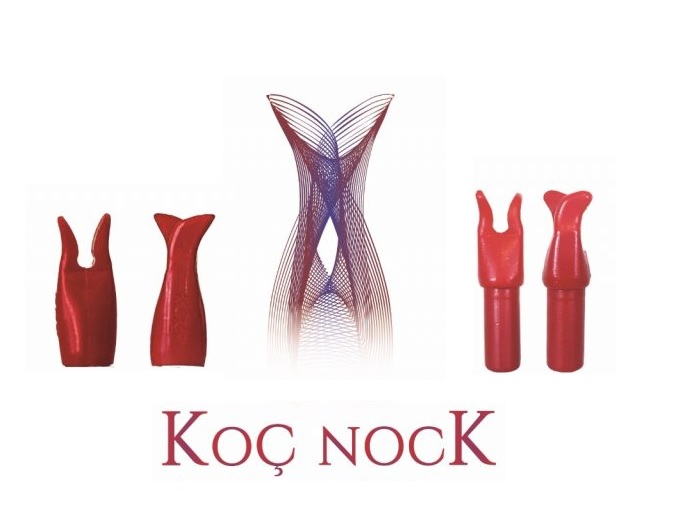Types of Arrows
Types of Arrows (Arrow History)
The humble arrow. The best friend of the bow. They have gone hand in hand for millennia. The arrow is to the bow what ink is to the pen, or gasoline to the internal combustion engine, or milk to your favorite cereal, you get the point. Just like bows, over the ages and across continents, the arrow has evolved and now comes in a variety of flavors. This article discusses all the variations in types of arrows.

The Oxford dictionary defines “arrow” as “a thin stick with a sharp point at one end, which is shot from a bow”. O.K. thanks, Oxford. Wikipedia’s definition is a much more thorough: “An arrow is a fin-stabilized projectile that is launched via a bow and usually consists of a long straight stiff shaft with stabilizers called fletchings, as well as a weighty (and usually sharp and pointed) arrowhead attached to the front end, and a slot at the rear end called the nock for engaging the bowstring.” Let’s go with this definition moving forward.
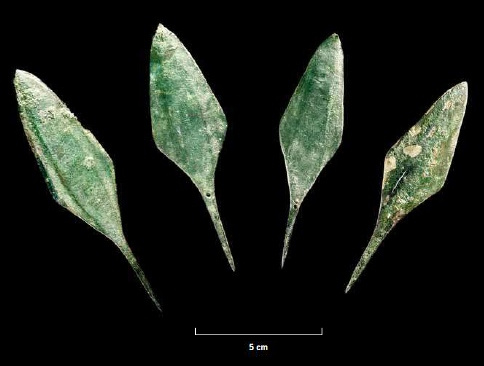
As we know from archery’s history, the bow goes way back. The arrow is also an ancient implement. The first archeological evidence of arrow-like projectiles comes from Sibudu Cave in South Africa. The artifacts in the cave were dated to be about 64,000 years old. The projectiles may or may not have been shot from a bow. A device known as an atlatl was used in prehistoric times to propel small spears or javelins. Pinewood arrows have been found in the Ahrensburg valley close to Hamburg dating to approximately 10,000 years ago. They had grooves at the bases where they would have been nocked onto a bowstring.
Types of Arrows: Terminology, Basics
There are some basic terms to be familiarized with before further discussing features of different types of arrows.

The Shaft refers to the cylindrical main body of the arrow. All the other parts of the arrow are attached to the shaft.
The Nock is the end of the arrow that receives the bowstring. Nocks can come in a variety of forms which will discuss later.
Fletching refers to the stabilizing fins of the arrow. Fletching helps the arrow to stabilize and stay true to its mark.
And finally the business end of things. The arrowhead is the end of the arrow which is intended to strike the target. A vast variety of arrowheads exist which serve a specific purpose. Wide, bladed arrowheads for hunting, compact pointy tips for piercing armor, even incendiary and whistling arrowheads exist.
Types of Arrows: Spine
A common term you’ll likely hear with regards to arrows is called it’s “spine”. The spine of an arrow refers to its rigidity or lack thereof. Four factors affect the arrow spine: 1) Arrow material. Some materials will naturally be more flexible or stiffer than others. 2) Bow draw weight. The heavier the draw weight, the more force will be compressing the arrow upon release. 3) Arrow length. The longer the arrow, the more it will be able to flex and bend. 4) The weight of the arrowhead. The heavier the arrowhead, the more it will cause the arrow to flex.
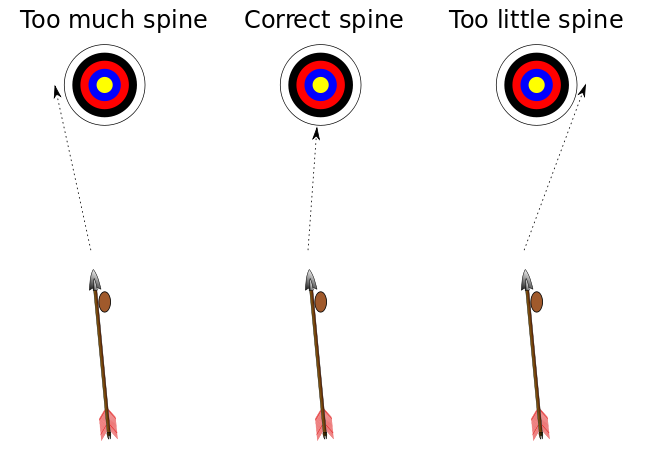
There is a specific number associated with an arrow’s spine. Arrow manufacturers typically suspend a given arrow at either end and hang a weight at the arrow’s center. The amount of deflection is then measured. A deflection of 0.400 inches gives the arrow a spine number of 400. Usually, bow manufacturers will publish an arrow spine chart that will assist you in determining a good arrow spine.
There can be some experimentation and trial and error involved in arrow selection. There is a sweet spot with arrows for a particular bow of given draw weight and length. Too much spine and the arrow will be very unforgiving, and there will be more deflection caused by the archer’s paradox. Too little spine and the arrow will flex and wobble too much, not allowing for any real consistency in placement. The following is an example spine chart from an arrow manufacturer:
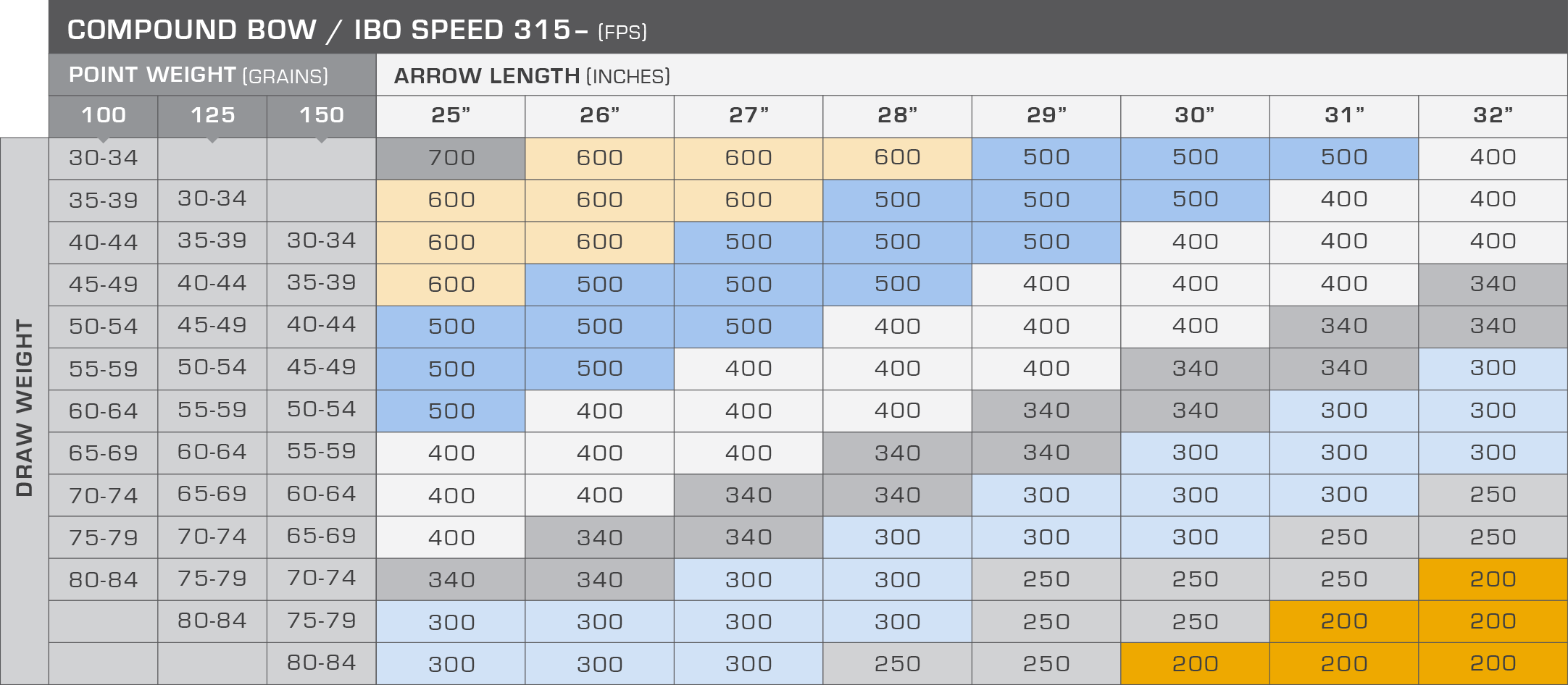
Types of Arrows: Fletching
As you may know, fletchings are the stabilizing fins on the one end of the arrow, opposite the arrowhead. Historically, the most common material for fletching was feathers. Unfortunately, arrow shafts and fletchings do not survive in the archeological record as they biodegrade easily. The only part of the arrow that survives is the arrowhead.
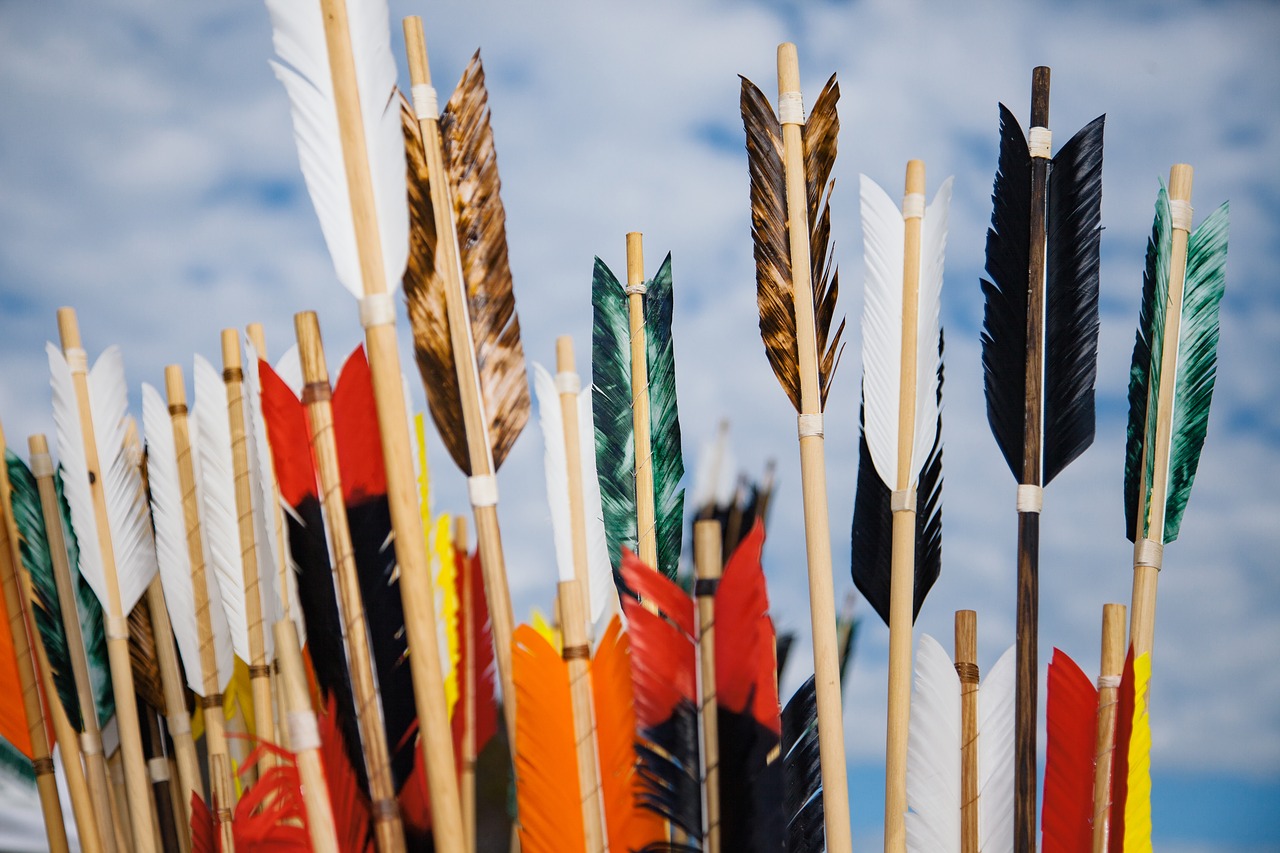
Nevertheless, it is clear that some sort of stabilizing fins were used as they are clearly depicted on ancient Egyptian and Assyrian wall carvings. As can easily be seen in ancient and medieval pictures/artwork, there were three main fletching types that were most prominent. 1) Triangular (long & short), 2) Parabolic 3) Sheild. We will discuss all three shortly.
Bird’s Feathers
In Medieval Europe, especially in Britain, the most common bird harvested for its feathers was the common gray goose. Arrow builders would use whatever bird was commonly available. The feathers from water foul such as ducks were common amongst the Magyars. Now let us examine some of the various shapes and configurations of fletching.
Triangular
This painting from the late 1400s very clearly depicts the long triangular shaped fletching that was common across Europe in the medieval era. This was the easiest and fastest fletching available for the arrowsmith.
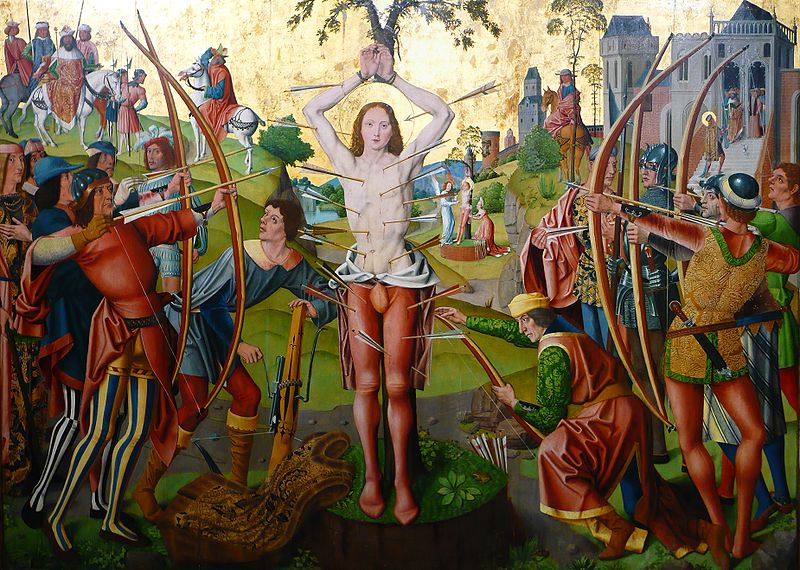
Parabolic & Shield
These two shapes of fletching are very similar in that they are rounded. This would have taken the arrowsmith longer to craft. A rounded shape must’ve been widely used as it appears in several paintings and tapestries throughout Europe throughout the middle ages. Illustrations from the Luttrell Psalter depict everyday life in medieval England. It was completed around the 1330s by various anonymous scribes. The following image depicts archers practicing with their neatly fletched arrows of parabolic shape.
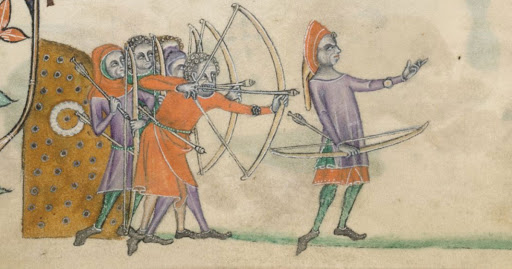
Modern Materials/Fletching
Modern synthetic material is now used to fletch arrows, although many archers prefer types of arrows with traditional feathers.
For modern recurves or compound bows, vanes are used instead of feathers (organic or synthetic). Since these bows are center shot (the bows are designed so the arrow rests in the center of the bow, directly behind the string) there will be no archer’s paradox. These vanes are usually made out of plastic.
Types of Arrows: Nocks
In case you didn’t know, the nock is the slit at the end of the arrow opposite the arrowhead. This slit receives the bowstring. A wide range of arrow nocks exists from all cultures through time. The simplest form of nock is what is known as a self knock. This is where a groove or slit is cut directly into the shaft. All types of materials, such as horn, bone, hardwood, metal were used to make reinforced nocks.
Below is an image of Turkish flight arrow nocks from The Flying Hun. They are made from two separate pieces of horn bound to the shaft.

Modern nocks are made from plastic and are quite durable. The following image is a patented nocking system for horseback archers. The helical shape ensures enables the arrow to be nocked very quickly through touch, there is no need to waste time looking at the string and the arrow.
Types of Arrows: Lengths/Dimensions
Arrow lengths varied throughout history. Although most arrows have an average length of about 28 to 30 inches. The arrows recovered from the Mary Rose contained several intact longbows as well as thousands of arrows. The arrows were all about 30 inches in length.
Turkish flight arrows have been the shortest. The arrows were made as small and therefore as light as possible because the objective in flight archery is to see how far the arrow can travel. Special devices such as a siper can be used to overdraw such short arrows. Overdrawing refers to drawing the arrow past the bow, which is usually not recommended.

Most historic arrows were roughly cylindrical, yet some cultures such as the Turkish and Chinese produced barreled arrow shafts. These arrows taper bidirectionally from the center. This made the arrow lighter yet strong enough to resist too much flexion.
Types of Arrows: Arrowheads
As mentioned previously, the part of an ancient arrow most likely to survive is the arrowhead. Because of this, we can see the truly vast array of different arrowheads used throughout history. Most arrowheads were inserted into the shaft. Conversely, some arrowheads are designed as a “cap” to accept the arrow shaft. We will try to go over as many as we can here without being too overbearing.
Flint/Stone
The earliest arrowheads ever made! Other than simply sharpening the shaft itself, this is the simplest and most primitive arrowhead. Put a sharp stone on the end of the arrow shaft. The arrow shaft was usually split slightly and the flint or stone arrowhead was inserted. Twine could also be tied around the arrowhead and the shaft for added security and strength.
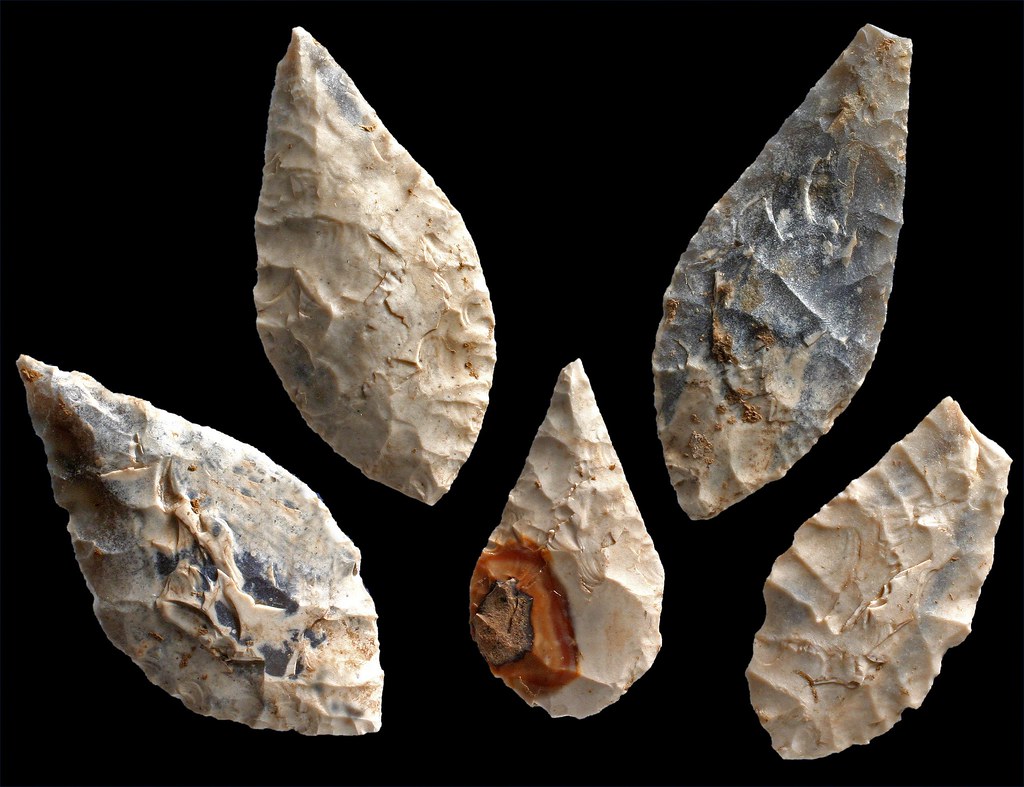
These arrowheads have survived intact for tens of thousands of years. Some of these arrowheads may have been spear points. It is difficult if not impossible to know for certain. The most common material for these ancient arrowheads was obsidian, flint or quartz. These materials easily flake and can be shaped to have very sharp edges and points.
Bone/Horn
Another ancient material for arrowheads is the bones or horns of animals. In the Great Plains of North America, where suitable rocks and stones were in short supply, the horns and bones of animals are ideal for arrowheads.
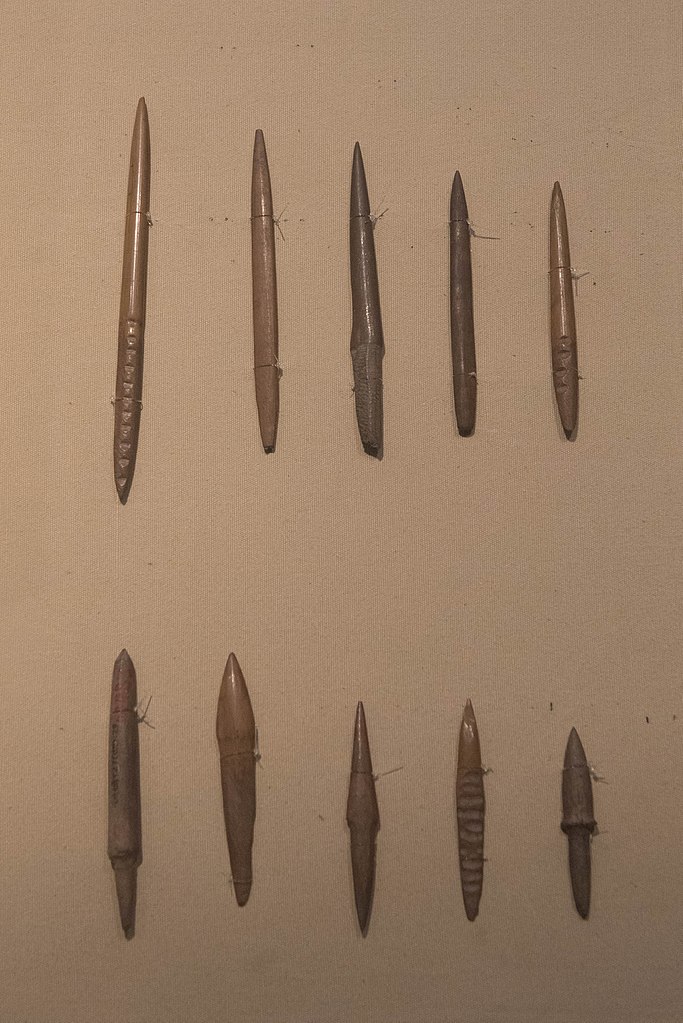
The Roman historian Ammianus Marcellinus (born circa 330, died circa 391 – 400) writes that the Huns would use bone tipped arrows: “because they fight from a distance with missiles having sharp bone, instead of their usual points, joined to the shafts with wonderful skill”. The Huns did retain skill in metallurgy and also produced a variety of metal arrowheads that show up in the archeological record.
Metal (Copper, Bronze, Iron)
The next great technological breakthrough for humanity after the discovery and taming of fire was metal. The use of metals for tools would bring the human race out of the stone ages. Since the discovery and use of the earliest metals, we have made arrowheads out of them. The first metal used was copper. It is relatively abundant and easily formed. It can be smelted from ore at a relatively low temperature. The following is a timeline pertaining to the history of metal arrowheads.
Copper Age Arrowheads, c. 3500 – 2000 B.C.
As mentioned the earliest metal arrowheads were made of copper. These arrowheads are characterized by their flat shape and tang for fitting into the arrow shaft. They are made of hammered copper. First made in Anatolia (modern-day Turkey) and spread to Egypt and the Middle East.

Bronze Age Arrowheads, c. 2200 – 1200 B.C.
Simple copper arrowheads gave way to larger, more complex bronze ones. Bronze is an alloy of copper and tin, which is considerably stronger than copper alone. These arrowheads were in use for a very long time.
Iron Age Arrowheads, c. 1200 – 690 B.C.
Iron is abundant but has a melting point of 1,538 °C (2,800 °F) which was unattainable for most kilns and blacksmiths until the second millennia B.C. When Iron was finally used it provided an exceptionally strong material for arrowheads.
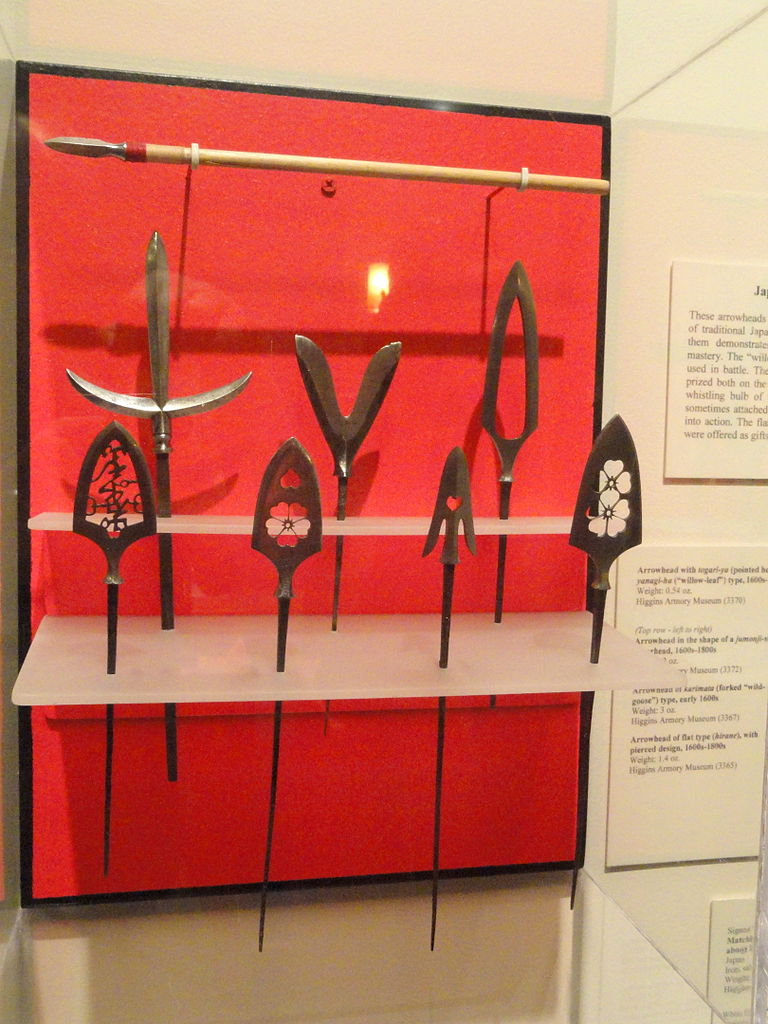
If you want a great resource for ancient, metal arrowheads, we strongly recommend this article from www.forumancientcoins.com. The thourough and well sourced article on metal arrowheads categorizes them on chronological and geographical lines as follows:
Copper Age, c. 3500 – 2000 B.C.
Bronze Age, c. 2200 – 700 B.C.
Iron Age, c. 1200 – 690 B.C.
Scythian, c. 690 – 350 B.C.
Graeco-Scythian, c. 650 – 250 B.C.
Hellenistic Greek, c. 350 – 30 B.C.
Achaemenid Persian, c. 550 – 330 B.C.
Parthian, c. 247 B.C. – 224 A.D.
Sasanian Persian, 224 – 800 A.D.
Roman, c. 300 B.C. – 476 A.D.
Romano-Byzantine, c. 330 – 1453 A.D.
Mongol (Khanate of the Golden Horde), c. 1200 – 1400 A.D.
Medieval Western Europe to England, after 1000 A.D.
Petrie, W. in his work: Tools and Weapons. (London, 1917) classifies the many varied metal arrowheads discovered into the following way, according to shape:

Modern Arrowheads (Steel)
One of the last evolutionary steps in metallurgy came with steel. Steel is a mixture of iron and carbon in varying ratios. Most high end, modern hunting arrowheads are made from a steel alloy.
Broadhead
Arrowheads classified as broadheads have been used since ancient times for hunting and warfare. They are still used today by most bowhunters. As their name implies, they have broad, bladed wings that are designed to cut and penetrate. Most broadheads are made from steel and have 2 to 4 broad cutting edges which facilitate bleeding in the victim.
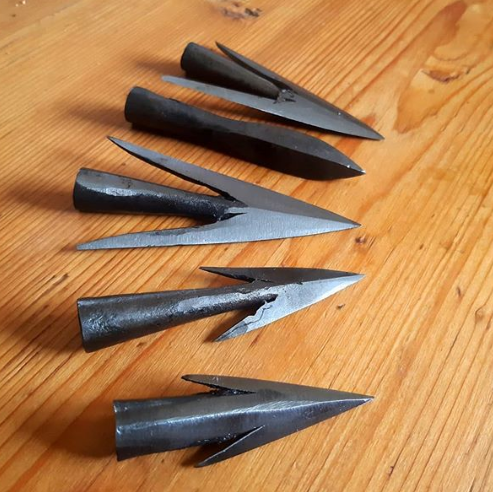
There are fixed blade broadheads, which are one solid piece, and mechanical broadheads. Mechanical broadheads will, upon contact, mechanically open with the blades swinging to give a larger cutting surface. These arrowheads are usually more aerodynamic than fixed blade versions as the blades are tucked into the arrow assembly. Mechanical broadheads sacrifice some kinetic energy and penetrations as it is spent deployed the blades. These arrowheads can cause a lot of damage and are not recommended for target shooting.

Bodkin Point
An arrowhead with a triangular or square-based pyramidal shape. Usually made from unhardened steel or iron, the possible original purpose of Bodkin points was to supply a cheaper easier to manufacture arrowhead compared to broadheads. These arrowheads also have a very small cross-section so they would extend arrow flight. They were also effective when it comes to penetration.
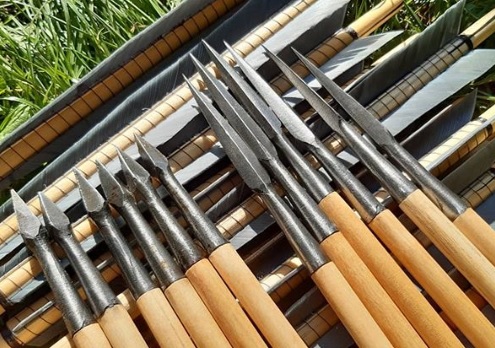
Many hundreds of thousands of these arrowheads were forged and used in the Hundred Years War, between England and France in the 14th and 15th centuries A.D. English Longbowmen’s arrows had to go up against the plate armor of French Knights. Most evidence suggests that the thick armor plating of the French Knights would effectively repel arrows, including ones with bodkin points.
Incendiary
Incendiary arrows have been used throughout history, particularly in sieges. A common type found in the archeological record is iron ones. A small “cage” is formed behind the actual arrowhead. Various flammable materials are placed within the compartment and set on fire before the arrow is discharged.

Whistling
Arrowheads with small hollowed-out grooves that produce a whistling noise have been known to exist since antiquity. A practical application of these arrows is as a means of signalling and communication during intense, chaotic battles.
Poison Tip
The use of poisons has been with us throughout all of human history. Applying poison to arrowheads would have been a logical delivery method for these toxins. Native hunter-gatherers in the Amazon basin still poison there arrows and blowdart tips with tree frog toxin. The Scythians were also widely known to apply various toxins derived from snakes and feces to their arrowheads. Don’t mess with Scythians.

Field Point
Field points, similar to “target points” are small, bullet-shaped arrowheads typically used in practice. They are intended to cause minimal damage and penetration to the target, making them ideal for target practice.

Judo Point
Judo points have small, spring-loaded wires which deploy upon contact. This allows the arrow to firmly grab onto grass or other surfaces. Utilizing Judo points increases the survivability of arrows when shooting outdoors in grassy areas. They are mainly used for hunting small game or outdoor target practice.
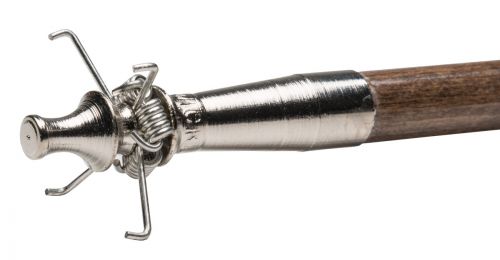
Blunts
Blunts or blunt points are flattened or blunted arrowheads. They are typically used in target shooting or hunting small game where concussive force, not penetration is required to kill. Blunts are made from a variety of traditional and modern materials such as wood, rubber, metal, and plastic.
Materials for different types of Arrows
Traditionally and historically, arrows (specifically arrow shafts) are made of wood. Strong, yet light woods were preferable. Various common woods used were:
Spruce, pine, cedar, and birch. Bamboo and reeds were also a very popular material for arrow making.
As mentioned previously, arrowheads were built using materials and technology that were available at the time; stone, bone, horn, metals.
The fletching was accomplished with feathers, and in modern times with various synthetics.
Popular modern arrow shaft materials are carbon, aluminum or fiberglass.


